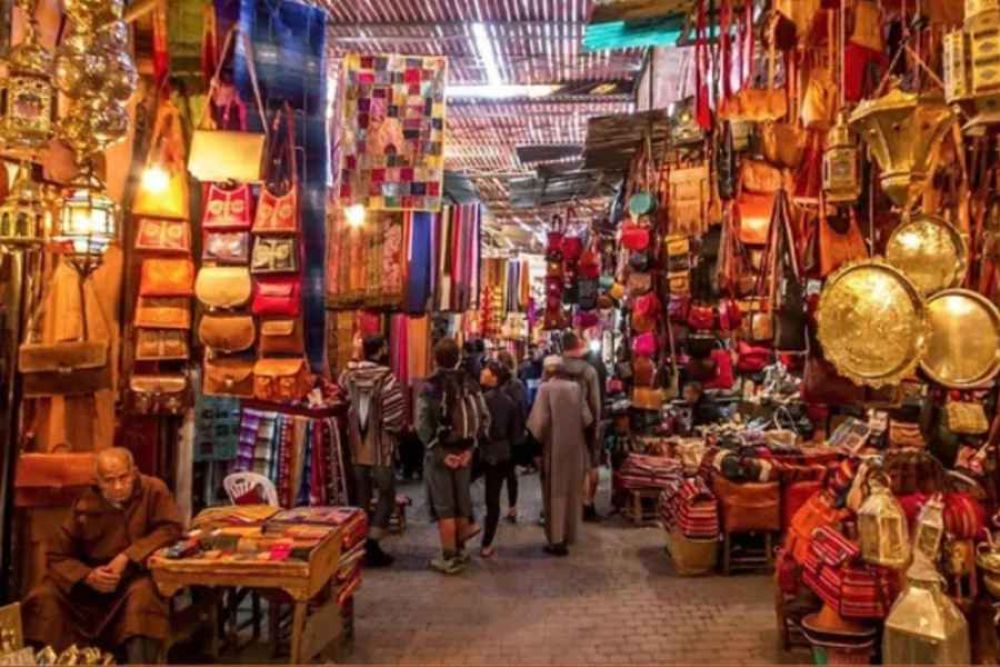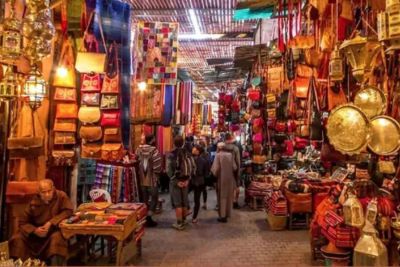

Explore the nuances of traditional Omani culture with a shopping spree in Buraimi Market located in Al Ain, close to the Oman-UAE border. This bustling marketplace is a treasure trove of Omani handicrafts, where you can find everything from intricately woven fabrics to handmade pottery. As you meander through the narrow alleyways, the scent of frankincense fills the air, and the vibrant colors of textiles catch your eye. Don't miss out on trying your hand at haggling, a customary practice here, to get the best deals on souvenirs, such as Bedouin jewelry or wooden carvings. The market is also an excellent place to taste local delicacies like Omani halwa, a traditional sweet, or purchase some freshly ground Omani coffee. Visitors often marvel at the silverware and traditional Omani Khanjars (daggers) on display, which are symbols of prestige and craftsmanship in Omani culture.
The Date Palm Oasis tour is an educational journey through one of the most cherished landscapes of the region. Buraimi is known for its lush palm groves, and the oasis in Al Ain offers a chance to discover the importance of date cultivation in Omani tradition. On this tour, you'll walk among the verdant fields, learning about the different varieties of dates, the harvesting process, and the sustainable irrigation system known as 'falaj' that has been in use for centuries. The tour guides are often locals, happy to share their knowledge and stories about the oasis life. Besides learning, you’ll have the opportunity to sample some of the freshest dates you've ever tasted, right from the source. The culmination of the tour presents a picturesque scenery ideal for capturing memories of your travels in Oman.
Al Ain Museum, situated near Buraimi Market, is a gateway to the rich history and culture of the region. Your exploration here will be a deep dive into the past, as the museum houses a comprehensive collection that depicts the way of life of the local people from ancient times to the present. The ethnographic section showcases traditional Omani garments, musical instruments, and day-to-day items, while the archaeological area takes you back in time with its display of artifacts unearthed in and around Al Ain. Each exhibit holds a story, shedding light on the transitions of time and advancements in Omani society. This insightful trip can play a crucial role in understanding the depth of history that underpins the vibrant market life you witness outside and the traditions that remain an integral part of Omani identity.
A not-to-be-missed experience when visiting Al Ain near Buraimi Market is the vibrant Camel Market. This lively market provides a unique glimpse into the traditional Bedouin lifestyle, where camels, considered a symbol of pride and wealth, are bought and sold. As you enter the market, the sight of camels of varying sizes and colors is instantly enthralling. The sounds of vendors calling out their prices and the bartering between buyers and sellers add to the authenticity of the experience. Visitors can learn about the significance of camels in Omani culture, the different breeds, and their uses, be it for racing, milk, or as a means of transport. Remember to ask for permission before taking photographs and to treat animals and vendors with respect. A local guide can help facilitate interactions and ensure a respectful and enlightening visit.
Get your hands dirty with a traditional Omani craft at a pottery workshop experience. Buraimi Market and the adjacent areas are known for their skillful pottery artisans. These workshops provide a hands-on opportunity to learn about the process of creating pottery items, which has been part of Omani heritage for generations. Under the guidance of a master potter, you'll be introduced to the clay preparation, spinning, and molding techniques. This activity is not just about watching; it's about creating your own piece of earthenware. You'll feel the clay transform under your fingertips, and with some dedication, you'll have your own crafted souvenir to take home. It's a therapeutic process and a creative way to connect with Omani traditions, perfect for families, couples, or solo travelers.
The henna art session is a cultural staple in the life of Omani women, and now visitors too can partake in this traditional beauty ritual. Situated just around the Buraimi Market area are skilled henna artists who can adorn your hands and feet with beautiful, temporary henna designs. For centuries, henna has been used in the region for its cooling properties and its significant role in celebrations such as weddings and Eid. Joining in on a henna session is not only about the aesthetic but also about experiencing an age-old practice and its societal importance. You will learn about the different symbols and patterns used, each carrying its own meaning, and you might even pick up stories behind traditional designs. It’s a peaceful experience, often accompanied by the scent of incense and the soft sound of Omani music in the background.
Indulge in the flavors of Oman by joining a cooking class that specializes in traditional Omani cuisine. Near the bustling environment of Buraimi Market, find a culinary escape where local chefs or culinary experts teach you how to prepare signature Omani dishes. The session will typically start with a brief market tour, where you'll learn to select the best spices and fresh ingredients essential for Omani recipes. You'll then move to the kitchen, where you'll be guided through the process of creating dishes like Shuwa, a slow-cooked marinated lamb dish, or Majboos, a spiced rice dish that is a staple in Omani households. This activity is an amazing way to immerse yourself in the culture, learn new cooking skills, and savor the delicious fruits of your labor at the end of the class.
The historical walking tour is a journey through time, encapsulating the unique blend of ancient traditions and modern advancements scattered around the Al Ain area close to Buraimi Market. Led by knowledgeable guides, the walking tour often starts with Buraimi's traditional markets and moves towards notable landmarks, including forts, towers, and mosques that have stood the test of time. It's not only an exercise for the body but also for the mind as the stories and historical facts shared by the guide provide context to the architecture and societal evolutions of the region. Key stops might include the Al Ain Oasis, Al Jahili Fort, and Al Qattara Souq, each site contributing to the historical puzzle that makes up the rich tapestry of Omani and Emirati heritage.
Just beyond the realm of the city and the traditional marketplace lies the majestic landscape of the desert. The desert safari adventure kick-starts from Al Ain, offering a thrilling excursion into the sandy dunes near the area of Buraimi. This exhilarating trip involves dune bashing, where you'll climb into a 4x4 vehicle driven by an expert and race across the dunes, feeling the rush of the slopes and dips. As part of the safari, you can witness a spectacular desert sunset, try out sandboarding, and even enjoy a traditional Omani BBQ dinner under the stars, accompanied by Arabic music and dance. The desert safari encapsulates the spirit of the Arabian nights and is a thrilling way to engage with the natural beauty of the Omani desert landscape.
The falconry experience is a fascinating dive into the world of these majestic birds of prey, which hold a cherished spot in Omani and Arab culture. In close proximity to Buraimi Market, there are opportunities to witness the art of falconry, which has been practiced in the region for centuries. Expert falconers demonstrate the training, hunting skills, and the deep bond between the falcon and its handler. For many visitors, the highlight is the chance to don a falconer's glove and have a falcon land on their arm, a truly awe-inspiring experience. Participants will learn about the various types of falcons, their conservation, and their vital role in the heritage of the region. It's an activity that combines cultural enlightenment with an adrenaline-pumping interaction.
